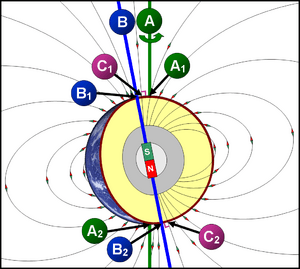Geographical pole facts for kids
A geographical pole is a special point on a planet like Earth. Imagine a spinning top: the geographical poles are the two spots where the imaginary line it spins around (called the axis of rotation) touches its surface.
On Earth, we have two main geographical poles:
- The North Geographical Pole is located at 90 degrees north of the equator.
- The South Geographical Pole is located at 90 degrees south of the equator.
These poles are important for understanding how our planet moves and for creating maps.
Contents
What is the Axis of Rotation?
The Earth is always spinning, like a basketball on a fingertip. The invisible line that goes through the center of the Earth, from the North Pole to the South Pole, is called the axis of rotation. This axis is what the Earth spins around once every 24 hours, giving us day and night.
Do the Poles Move?
Yes, the geographical poles on Earth do move a little bit! They shift by a few meters over several years. This movement is very small, but it's caused by things like changes in how water moves around the Earth, or even how the Earth's core behaves.
Fixed Points for Maps
Even though the geographical poles move slightly, mapmakers need fixed points to create accurate maps. So, for cartography (the art of making maps), scientists use the average positions of the geographical poles as if they were fixed. These fixed points are sometimes called cartographic poles. They are where all the longitude lines on a map meet.
Related Topics
- Magnetic pole: Learn about the Earth's magnetic poles, which are different from the geographical poles and are where compasses point.
See also
 In Spanish: Polo (cartografía) para niños
In Spanish: Polo (cartografía) para niños


